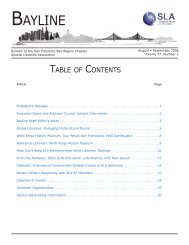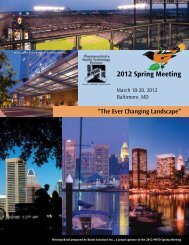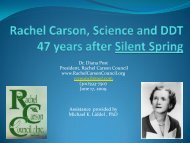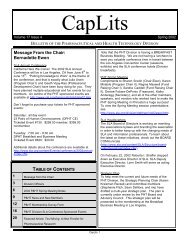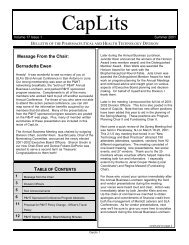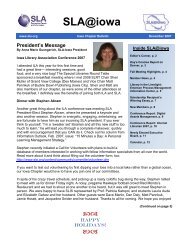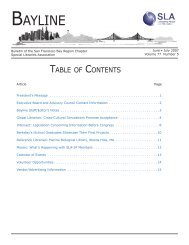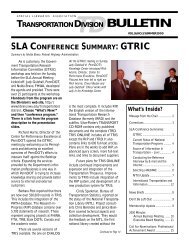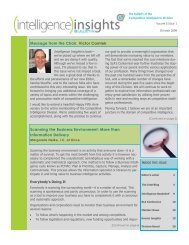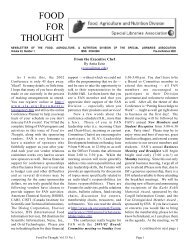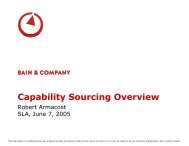Education Libraries - Special Libraries Association
Education Libraries - Special Libraries Association
Education Libraries - Special Libraries Association
You also want an ePaper? Increase the reach of your titles
YUMPU automatically turns print PDFs into web optimized ePapers that Google loves.
foundations and they linger nicely in musing about “The<br />
Nature of Curriculum” (chapter 1) and review concept<br />
and types of curriculum, including the hidden<br />
curriculum. This reviewer found their chapter 2,<br />
“Curriculum History” to be overlooked in many other<br />
curriculum texts and tells the tale of the rise and fall of<br />
curriculum trends. Even undergraduates in teacher<br />
education programs will be able to find parallels to their<br />
own years of experience as a K-12 student. The authors’<br />
tidy explanation of how each new wave of curricular<br />
reform was played out in schools is fascinating and they<br />
do a nice job of tying each phase through transitions to<br />
the next. The book continues through Part 1 to review<br />
politics of curriculum and basic curriculum theory.<br />
Part 2 focuses on curriculum planning and takes the<br />
reader from the conceptual stages of planning, through<br />
the general program of study, to specific fields, and<br />
finally to the processes used in the development of new<br />
courses and unit. The detail in the planning process,<br />
beginning with concepts and ending in what the<br />
classroom teacher implements in the classroom is an<br />
example of the thorough approach used in this text. Part<br />
3 moves to managing the curriculum, and begins with<br />
supervising both the curriculum and how it is taught,<br />
including concepts of motivating teachers to move to a<br />
new curriculum and teaching strategies. Part 3 continues<br />
with curriculum implementation, alignment, and<br />
evaluation. Part 4 focuses on current trends, and includes<br />
discussions of specific subject fields, issues such as new<br />
technologies and new assessments. Adaptations for<br />
diverse learners are also discussed in this section.<br />
Curriculum Leadership will have a prominent place on<br />
the shelves of education libraries. Along with its value as<br />
a text for curriculum classes, it is a reliable ready<br />
reference tool for students at any level in the education<br />
field to check understanding of terms, review for<br />
comprehensive exams, and find support materials for<br />
class assignments. The real strength of this resource is<br />
the thorough approach. An extremely valuable resource<br />
for any library focused on education.<br />
Dr. Gail K. Dickinson is an Associate Professor at Old<br />
Dominion University. Email: gdickins@odu.edu<br />
More than 100 Tools<br />
for Developing<br />
Literacy—Reviewed<br />
by Barbie E. Keiser<br />
Groeber , Joan F.<br />
(2008). More than 100<br />
Tools for Developing<br />
Literacy. 2 nd ed.<br />
Thousand Oaks, CA:<br />
Corwin Press. ISBN:<br />
978-1-4129-6437-1<br />
(pbk.), 978-1-4129-<br />
6436-4 (cloth). $28.95<br />
(pbk.), $62.95 (cloth).<br />
I opened the book not expecting much—my interest is in<br />
information literacy and the title of the book made clear<br />
that its focus was reading—but from the first paragraph<br />
of the preface I was hooked. The premise of this<br />
ingenuous volume by Joan F. Groeber, an independent<br />
consultant and lecturer in the field of literacy and<br />
assessment, is that we must determine “what students<br />
need to know to progress through the educational system<br />
with some measure of success.” She recommends that<br />
we analyze the methods and strategies that successful,<br />
effective learners “employ to comprehend and respond<br />
to classroom materials” with a goal of “helping less<br />
experienced learners adopt these techniques.” (p. vii)<br />
The book succeeds in offering “a clear blueprint for the<br />
acquisition of ‘life skills’ based on what works for<br />
effective learners” (p. viii), which is precisely the link<br />
that we make between information literacy and lifelong<br />
learning.<br />
There are eight brief chapters (consisting of a mere three<br />
pages!) and while these pages are crucial, the 10-16<br />
innovative exercises that comprise the rest of each<br />
chapter make this an invaluable book. Each exercise<br />
consists of a brief paragraph providing background—<br />
why this exercise is important and what it will do for the<br />
student—a description of the activity and questions that<br />
can guide discussion in the classroom. The author<br />
indicates whether the exercise is suitable for independent<br />
reading and small group discussion, for example, and<br />
suggests both formal and informal assessments. The<br />
book progresses from primary grades to middle school to<br />
high school addressing the level of comprehension<br />
necessary at each stage.<br />
Ms. Groeber lets us know precisely what each chapter is<br />
about through accurate titles. In Chapter One, titled,<br />
<strong>Education</strong> <strong>Libraries</strong>, Volume 31, No. 2, Winter 2008 52



